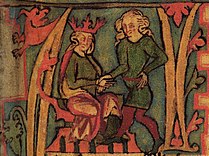
By Michelle Styles
One of the problems with researching the early Vikings is that so much is shrouded in myth and mystery. Various sources mention the Ynglings as an early Norse dynasty, but how real were they? And do they still exist today?
The Ynglings are known as semi-legendary because scholars are fairly certain they existed; they are mentioned in a number of independent sources that appeared shortly appeared after the Age of Migration finished in around 700 AD. The problem with the Age of Migration or the Dark Ages is very few primary sources exist for the tribes who were migrating around Europe. The Ynglings are mentioned in Saxo Germanicus, Beowolf (in Beowolf, they are referred to as Scyling), and in the Ynglinga saga and a shorter work by Snorri Sturulson.
Yngling means "descendant of Frey" and they supposedly subdued most of Sweden between the 500-700 AD. Sturluson also mentions that they may have been descended from a man called Skelfir, and thus were more properly called Skalfings.
One of the most famous of the Ynglings, Ottarr or Ohthere, refused to pay tribute to the Danish king Frodi (and yes, you do have the Anglican version, Frodo, used by Tolkien--encountering Tolkien is a slight hazard when researching the early Vikings!), and freed his part of Sweden from the tribute. He and his sons are mentioned in Beowolf and Saxo Germanicus. The details are vaguely given which leads some scholars to conclude that the story was so well known that the skalds did not have to relate the full details.
 The last Yngling king in Sweden was Ingjald Ill-Ruler who enlarged his kingdom with the simple expedient of burning the other kings inside his hall. His daughter Asa was considered to be devious. One of his sons, Olof Tratalga, who was the last true Yngling, ruled part of Norway for awhile but proved such a bad ruler that he was eventually burnt to death in his long house. The remains of burnt long house dating from this time and roughly in the correct area have been found.
The last Yngling king in Sweden was Ingjald Ill-Ruler who enlarged his kingdom with the simple expedient of burning the other kings inside his hall. His daughter Asa was considered to be devious. One of his sons, Olof Tratalga, who was the last true Yngling, ruled part of Norway for awhile but proved such a bad ruler that he was eventually burnt to death in his long house. The remains of burnt long house dating from this time and roughly in the correct area have been found.
 Later, the descendants of Harald Finehair (so called because he refused to cut or comb his hair until after a certain princess, Gyda, married him, something she refused to do until he became king of all Norway) claimed to be part of the Yngling dynasty in order to give Finehair's unification of Norway some legitimacy in the early 9th century. The Finehair dynasty (or at least claims to have been descended from him) ruled Norway until about the 14th century. If you do various twists and turns and leaps of faith, the current Norwegian kings are related.
Later, the descendants of Harald Finehair (so called because he refused to cut or comb his hair until after a certain princess, Gyda, married him, something she refused to do until he became king of all Norway) claimed to be part of the Yngling dynasty in order to give Finehair's unification of Norway some legitimacy in the early 9th century. The Finehair dynasty (or at least claims to have been descended from him) ruled Norway until about the 14th century. If you do various twists and turns and leaps of faith, the current Norwegian kings are related.
So real or not, it is interesting that some in Norway would still claim descent from the Ynglings.
One of the problems with researching the early Vikings is that so much is shrouded in myth and mystery. Various sources mention the Ynglings as an early Norse dynasty, but how real were they? And do they still exist today?
The Ynglings are known as semi-legendary because scholars are fairly certain they existed; they are mentioned in a number of independent sources that appeared shortly appeared after the Age of Migration finished in around 700 AD. The problem with the Age of Migration or the Dark Ages is very few primary sources exist for the tribes who were migrating around Europe. The Ynglings are mentioned in Saxo Germanicus, Beowolf (in Beowolf, they are referred to as Scyling), and in the Ynglinga saga and a shorter work by Snorri Sturulson.
Yngling means "descendant of Frey" and they supposedly subdued most of Sweden between the 500-700 AD. Sturluson also mentions that they may have been descended from a man called Skelfir, and thus were more properly called Skalfings.
One of the most famous of the Ynglings, Ottarr or Ohthere, refused to pay tribute to the Danish king Frodi (and yes, you do have the Anglican version, Frodo, used by Tolkien--encountering Tolkien is a slight hazard when researching the early Vikings!), and freed his part of Sweden from the tribute. He and his sons are mentioned in Beowolf and Saxo Germanicus. The details are vaguely given which leads some scholars to conclude that the story was so well known that the skalds did not have to relate the full details.
 The last Yngling king in Sweden was Ingjald Ill-Ruler who enlarged his kingdom with the simple expedient of burning the other kings inside his hall. His daughter Asa was considered to be devious. One of his sons, Olof Tratalga, who was the last true Yngling, ruled part of Norway for awhile but proved such a bad ruler that he was eventually burnt to death in his long house. The remains of burnt long house dating from this time and roughly in the correct area have been found.
The last Yngling king in Sweden was Ingjald Ill-Ruler who enlarged his kingdom with the simple expedient of burning the other kings inside his hall. His daughter Asa was considered to be devious. One of his sons, Olof Tratalga, who was the last true Yngling, ruled part of Norway for awhile but proved such a bad ruler that he was eventually burnt to death in his long house. The remains of burnt long house dating from this time and roughly in the correct area have been found. Later, the descendants of Harald Finehair (so called because he refused to cut or comb his hair until after a certain princess, Gyda, married him, something she refused to do until he became king of all Norway) claimed to be part of the Yngling dynasty in order to give Finehair's unification of Norway some legitimacy in the early 9th century. The Finehair dynasty (or at least claims to have been descended from him) ruled Norway until about the 14th century. If you do various twists and turns and leaps of faith, the current Norwegian kings are related.
Later, the descendants of Harald Finehair (so called because he refused to cut or comb his hair until after a certain princess, Gyda, married him, something she refused to do until he became king of all Norway) claimed to be part of the Yngling dynasty in order to give Finehair's unification of Norway some legitimacy in the early 9th century. The Finehair dynasty (or at least claims to have been descended from him) ruled Norway until about the 14th century. If you do various twists and turns and leaps of faith, the current Norwegian kings are related. So real or not, it is interesting that some in Norway would still claim descent from the Ynglings.